How to become PIPEDA Certified: A Step-by-Step Guide
Payal Wadhwa
Mar 26, 2025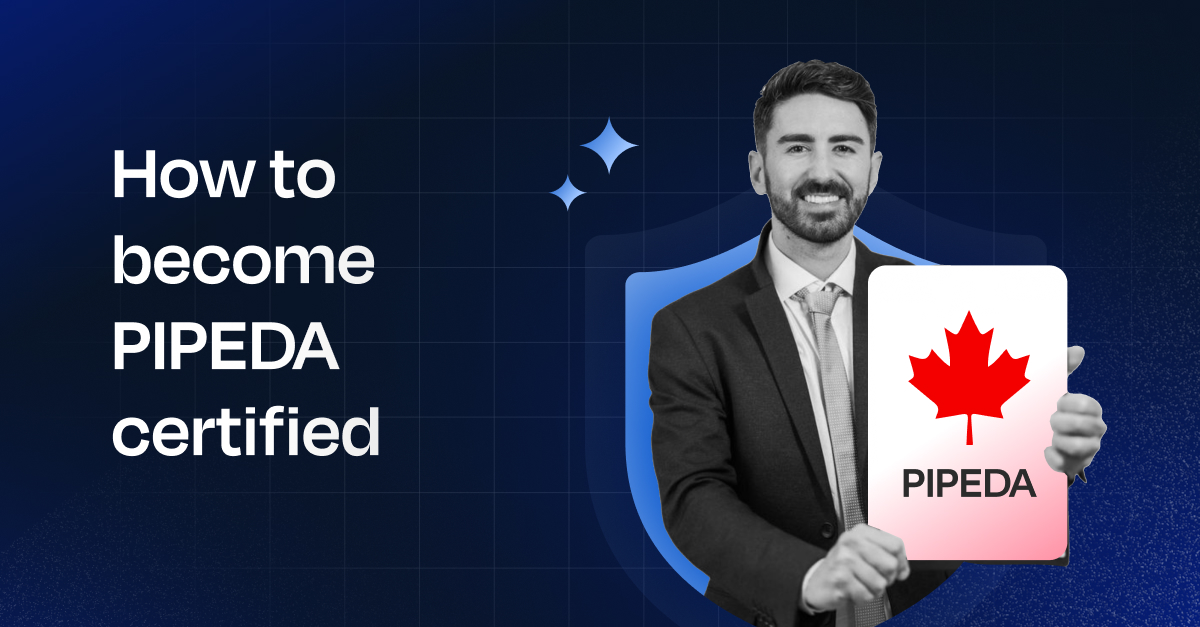
As of the 2024 report, 79.3% of the world’s population has been covered by some data privacy law, surpassing Gartner’s prediction of 75%.
With people becoming more aware of their privacy rights, compliance isn’t just a legal requirement anymore—it’s about building trust. Big names like TikTok and Meta have faced privacy violations, making it clear that businesses need to take data protection seriously.
But how do you prove your commitment to privacy? That’s where PIPEDA certification comes in.
PIPEDA is Canada’s key privacy law, applying to businesses that handle personal data in the region. In this guide, we’ll explain PIPEDA certification, how to achieve it, and the common challenges and misconceptions along the way.
| PIPEDA is Canada’s federal privacy law requiring businesses to protect personal data. While not an official government certification, third-party validation helps organizations prove compliance and build trust. |
| Key steps include appointing a privacy officer, conducting an information audit, performing a Privacy Impact Assessment, drafting privacy policies, implementing security measures, training employees, and managing third-party risks. |
| Achieving PIPEDA compliance can cost between $5,000 and $200,000+, depending on company size. Compliance helps businesses minimize regulatory risks, unlock enterprise deals, and expand to markets like the EU. |
What is PIPEDA Certification?
PIPEDA certification demonstrates compliance with PIPEDA, or the Personal Information Protection and Electronic Documents Act, Canada’s federal privacy law protecting personal information. It applies to all regional private-sector organizations that gather, use, or share personal data for commercial activities.
PIPEDA is enforced by the Office of the Privacy Commissioner (OPC) and requires organizations to implement technical and organizational measures to safeguard customer information and uphold their privacy rights.
Why do organizations need PIPEDA certification?
While PIPEDA is not a government-backed certification, organizations need compliance validation as they can be audited by the Privacy Commissioner and attract fines and penalties for violations.
The law aims to strengthen data security practices and minimize privacy risks by holding businesses accountable for personal information and ensuring that they adhere to the 10 principles laid out for compliance. It also gives customers the right to challenge compliance if they believe their data has been mishandled. This means that the more the organization can demonstrate compliance, the more it will be trusted by customers and attract bigger and better clients. Especially when you try to unblock a deal with enterprise clients, proof of privacy compliance is a sales accelerator.
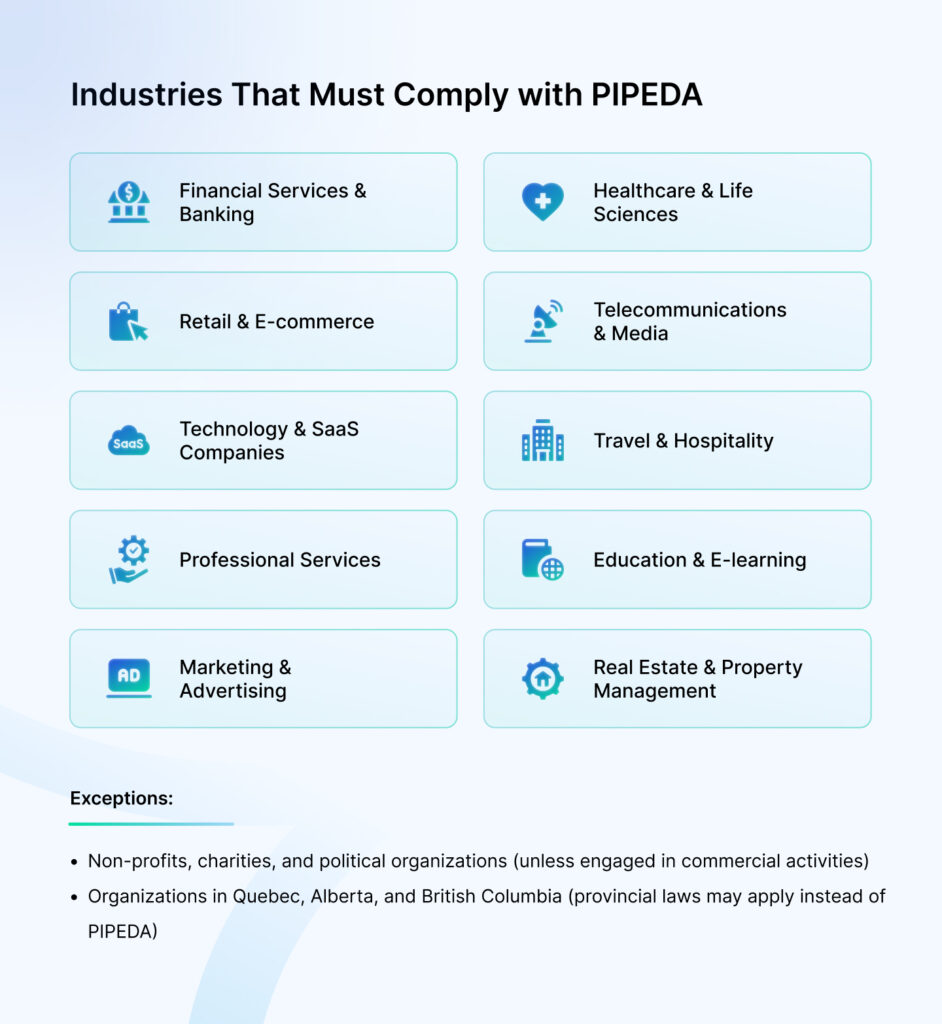
The European Commission has also recognized PIPEDA as providing adequate protection for data privacy. This implies that Canadian businesses can also offer services to EU clients with fewer obstacles. It helps support business expansion beyond borders.
How to Achieve PIPEDA Certification?
A PIPEDA compliance certificate validated by a third party can minimize the chance of regulatory scrutiny by helping you proactively identify and manage risks and strengthen data security.
Here are the steps that you can take to achieve PIPEDA:
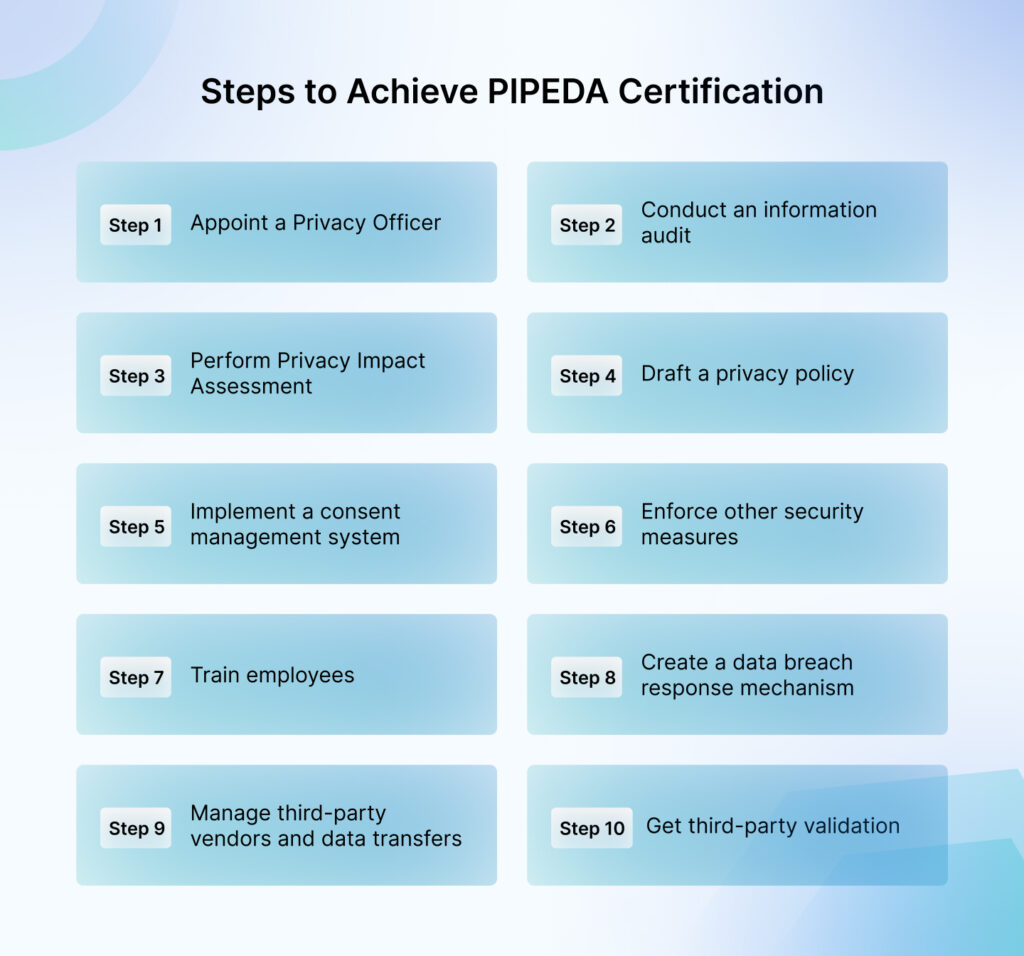
1. Appoint a Privacy Officer
Start by designating a Privacy Officer, as it is a mandatory requirement under the PIPEDA law. The privacy officer is an individual from the company responsible for ensuring adherence to the 10 principles of PIPEDA and overseeing the privacy management program. The key responsibilities of the privacy officer include:
- Creating and implementing privacy policies and processes that protect personal information and meet the requirements of the law
- Serve as an external point of contact for external queries and making outward-facing policies public
- Coordinate with third parties to ensure an appropriate level of protection when they handle personal information on behalf of the organization
- Demonstrate a culture of privacy within the organization
- Monitor and conduct regular audits of the organization’s privacy practices
As a general practice:
- Small organizations usually appoint a Chief Executive Officer (CEO), Chief Operating Officer (COO), and Chief Financial Officer (CFO) as the Privacy Officer.
- Mid-sized organizations appoint a GC or General Counsel as the Privacy Officer.
- Large organizations or enterprises have a separate GC and a Chief Privacy Officer.
- The CIO, CTO, and CISO are not appointed as privacy officers to minimize conflict of interest and avoid confusion between information security and privacy.
2. Conduct an information audit
The next step would be to conduct an information audit and map data flows to understand where data resides, how it moves internally and externally, and where improvements can be made.
The information audit will include:
- Data discovery and cataloging: Understanding what personal information is collected and cataloging it as customer data, employee data, vendor data, and other categories
- Assessing data sources: Determining the origin of data as internal or external
- Understanding data use: Evaluating how the data is used and processed across systems
- Legal considerations: Identifying applicable privacy laws such as GDPR and PIPEDA and ensuring compliance
The data flow mapping will include:
- Data collection: Understanding the mode of data collection, including forms, sign-ups, etc.
- Data processing: Determining how it moves across departments
- Data storage: Identifying where data is stored- cloud, servers or physical locations
- Data transfer: Examining data transfers with vendors and other external sources
- Data disposal: Evaluating data disposal, archival, and deletion practices
3. Perform Privacy Impact Assessment
Once you’ve identified the data involved and mapped data flows, start assessing the privacy risks using a privacy impact assessment. A PIA uses a mix of data analysis, data flow diagrams, stakeholder inputs, and expert evaluation to uncover risks such as:
- Collecting more data than necessary for the stated purpose
- Not obtaining meaningful consent from users involved
- Inadequate controls causing unauthorized access, breaches, or misuse
- Retaining personal information longer than required
- Inappropriate data handling by vendors
- There is not clear documentation about privacy practices, etc.
A PIA report with risks and tactical mitigation steps must be prepared for post-remediation comparison and review.
4. Draft a privacy policy
PIPEDA requires organizations to provide clear and accessible information on customer data collection and use under the openness principle. And while a written privacy policy is not mandatory, it is a best practice to build trust and ensure compliance.
Include the following components in a privacy policy:
- Data collection and purpose of usage: Describe what data is collected and how
- Cookie consent and user rights: Explain cookies and how users can access, update, or delete their data
- Retention of personal data: Clarify retention periods
- Data transfers: Disclose if data is shared externally and the protection measures followed
- Disclosure of personal data: Explain how data is disclosed to external parties
- Breach response and complaints: Give details on breach response mechanisms and methods for complaint handling
Host it on the company website and provide a direct link for easy access.
You can use custom policy templates from Sprinto and tailor them as per company needs.
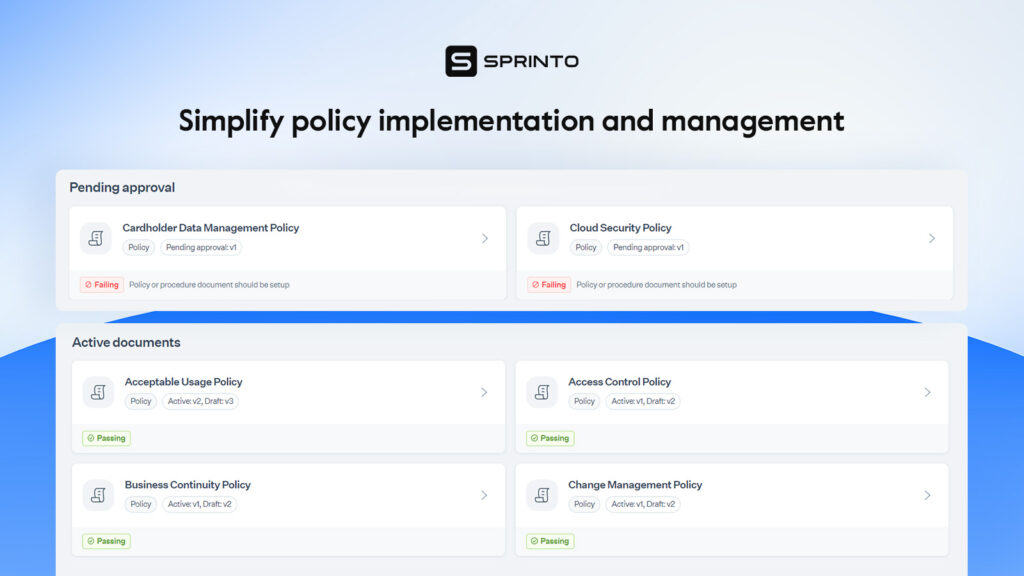
5. Implement a consent management system
Next, systems should be established to obtain meaningful customer consent before collecting, using, and disclosing their personal information. A consent management system will help you automate the process by:
- Scanning your website for cookies
- Create custom banners for opt-in consent or explicit consent (users take a clear action to indicate their agreement)
- Manage implicit consent allowed for non-sensitive data (for example, entering email ID to complete a purchase order)
- Manage opt-out or consent withdrawal through unsubscribe links, account settings, or revisiting consent widgets
- Maintain consent logs for compliance purposes
A well-designed consent management system will be user-friendly; users can deny or withdraw consent. Some popular choices include ConsentManager.net, Cookiebot, and CookieYes.
6. Enforce other security measures
Implement multi-layer safeguards to protect sensitive information against unauthorized access, theft, misuse, and disclosure. Key measures will include:
- Organizational safeguards such as security policies, third-party management, and incident response plan
- Physical safeguards such as secure disposal of electronic devices and physical documents, security cameras, and visitor logs
- Technical safeguards such as encryption, multi-factor authentication, firewalls, data anonymization and patch management
- Continuous monitoring and logging mechanisms
- Regular internal audits
7. Train employees
Arrange employee awareness and training programs tailored per roles to ensure PIPEDA compliance and ongoing support. The key areas covered under the training program will include:
Introduction to PIPEDA and the 10 Principles
- Handling personal information
- Data security practices
- Breach response
- Individual rights
- Responding to user requests
- Vendor risk awareness
Use real-life scenarios to reinforce concepts and conduct refresher training for regular updates.
8. Create a data breach response mechanism
PIPEDA requires organizations to report breaches that pose a real risk of significant harm (RROSH) to the OPC, so you must build an effective breach response mechanism.
Start by establishing a breach response team and creating a breach response plan. The plan will include steps to detect and contain the breach, assess risk, and notify the affected parties and authorities. The breach notification to the OPC will consist of the following details:
- Details on circumstances that led to the breach
- Date and time of the breach
- Personal information affected by the breach
- Risk assessment
- Number of individuals impacted
- Steps were taken to notify individuals
- Steps were taken to minimize the harm
- Point of contact details
The records of all breaches must be maintained whether or not they are reported as per the requirement.
9. Manage third-party vendors and data transfers
Ensure that consumers are aware of any data being processed outside Canada and that the vendors or third parties have comparable protection to safeguard data. Identify high-risk vendors and implement contracts with privacy and security clauses. Also, mandate the reporting of breaches by the vendor and continuously monitor and audit vendor compliance. When offboarding the vendor, revoke access to sensitive information and ensure all personal data is safely deleted.
10. Get third-party validation
Most organizations seek third-party validation for PIPEDA to demonstrate compliance. Organizations like CertPro can assess your organization and obtain a validation report to display on your website along with other recognized privacy certifications, such as ISO 27001.
With Sprinto, ensure your business complies with privacy laws
How much does it cost to achieve PIPEDA certification?
PIPEDA certification can cost about $5000-$30000 for small businesses, $30000-$100000 for medium businesses, and $100000 to $200000+ for large enterprises.
Although it’s not an official certification, many businesses opt for third-party assessments and audits to ensure compliance. Auditors like CertPro also offer services for PIPEDA assessments starting from $2500 for small businesses with 1-25 employees.
Here’s a breakdown of the cost components.
Internal compliance efforts ($5000-$50000+)
- Includes developing and maintaining privacy policies, conducting employee training and data risk assessments
Technological investments ($10000-$100000+)
- Include basic security measures such as consent management systems, encryption, firewalls, secure data storage, etc.
Legal and advisory costs ($5000-$25000+)
- Includes fee for drafting policies and handling disputes and investigations
Third-party assessments/audits ($2500+$10000+)
- Includes privacy assessments and PIPEDA compliance audits
The costs can vary based on existing infrastructure, scope of audit and number of locations, industry requirements, and data sensitivity.
Challenges in achieving PIPEDA certification
When striving to achieve PIPEDA compliance, there is a constant need to balance business interests, individual rights, and evolving technology. This creates complexities in adherence, especially since there is no universal privacy law, and each law requires subjective interpretation
The following are the challenges in achieving PIPEDA compliance:
Privacy laws are constantly evolving
Privacy expectations across the globe are rapidly evolving, with states, provinces, and countries frequently introducing new regulations. Consumers are becoming more aware of their rights, and technological advancements are making waves every other day. On top of that, organizations must undergo assessments and demonstrate compliance—all while managing their day-to-day operations, making compliance more complex by the day.
How to solve:
- Adopt a privacy-by-design approach
- Subscribe to newsletters and industry reports to stay on top of updates
- Appoint privacy officers and automate wherever possible
Some interpretations are tricky
Another challenge that businesses face is interpreting various sections of the law. For example, the standard relies on what a ‘reasonable person’ would consider appropriate in data collection, usage, and transfer. This interpretation is subjective and can depend on customer perception.
Similarly, organizations must determine when implicit consent is sufficient and when explicit consent is required. These interpretations can cause ambiguity and create implementation challenges.
How to solve:
- Engage with privacy officers and legal consultants
- Establish clear policies that state what is reasonable person and consent levels
Continuous consent management can get complex
Consent management is tricky because of changing user preferences, where customers can modify, grant, or withdraw consent at any time. There is also a need to manage consent across various platforms such as websites, mobile apps, and vendor integrations. Consent levels also vary, with email marketing requiring opt-in, while some basic services may have implied consent.
How to solve:
- Use centralized consent management platforms
- Offer clear and category-based consent preferences for users for better segmentation
Managing data transfers is challenging
The data transfer challenge lies in the fact that organizations must ensure each transfer is safe by assessing it on a case-by-case basis. There are no standardized measures for safeguarding data movement—certain provinces, such as Quebec with Law 25, have specific requirements, while transfers outside Canada must implement “sufficient and adequate” protections. This leaves a lot of room for interpretation and uncertainty.
How to solve:
- Establish data protection agreements with third parties and vendors
- Use recognized security measures for data transfers, such as encryption and access controls
Small businesses have resource constraints
Small businesses lack in-house expertise or dedicated privacy teams and operate with constrained budgets. Undergoing data risk assessments, implementing robust security controls, and maintaining compliance evidence and documentation require finances, human resources, and time. With them already managing multiple tasks, managing PIPEDA adds another layer of responsibility and complexity.
How to solve:
- Opt for affordable compliance automation tools
- Focus on basic cybersecurity hygiene measures such as MFA, encryption, and strong passwords
- Implement simple but effective privacy policies
Unlock the power and ease of compliance automation with Sprinto
Misconceptions about PIPEDA certification
The complexities of achieving PIPEDA also arise due to the misconceptions attached to compliance.
Let’s clarify the myths and misconceptions one by one:
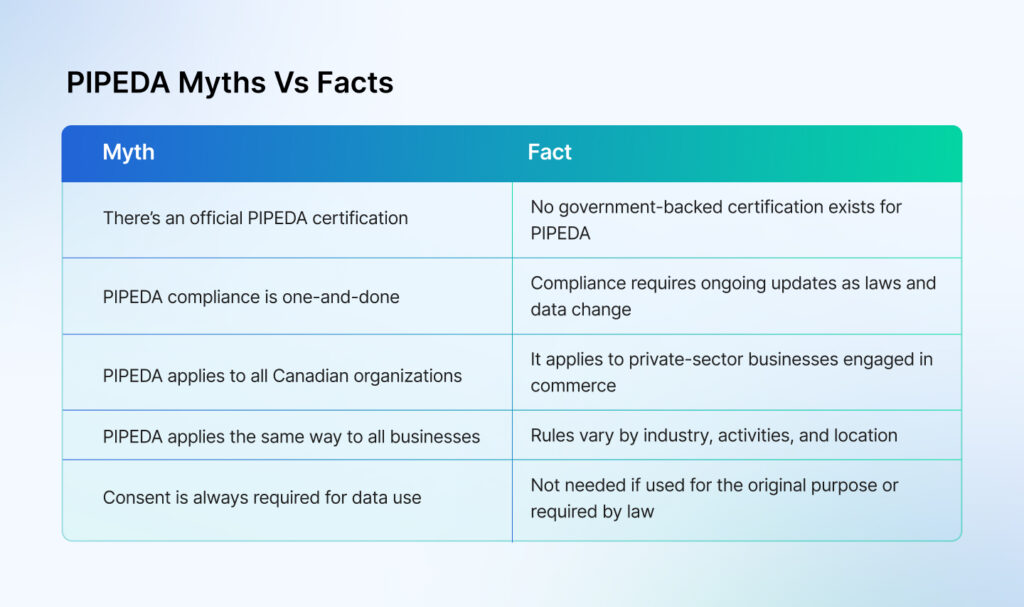
There’s an official certification
While the term ‘PIPEDA certification’ is commonly used, there is no government-backed certification for PIPEDA compliance. Organizations must align with the privacy principles outlined in the law and may undergo assessments to demonstrate compliance, but they cannot receive an official certification from the Canadian government. That said, compliance remains a priority for most private businesses in Canada due to increasing global privacy expectations and the potential consequences of non-compliance.
It’s one-and-done compliance
More often than not, organizations think that once they have implemented the privacy principles, the compliance exercise is done, and they’ve ticked the box. However, as data volume increases and laws evolve, there is a need for constant compliance management, and any misses can have financial, reputational, and legal repercussions while putting the compliance status at risk.
PIPEDA applies to all organizations and provinces in Canada
PIPEDA applies to private-sector organizations that use, collect, or disclose personal data for commercial activities and is not universally applicable to all organizations in Canada. Government entities, charity groups, and non-profit companies do not come under its purview when carrying out their core functions.
Similarly, it does not apply to provinces with their privacy laws, such as Alberta, British Columbia, and Quebec, when businesses operate only within their borders.
It applies to all organizations in the ‘same way’
PIPEDA implementation is not the same for all organizations because the application differs based on the type of organization, activities, and location.
Here’s an example: The law applies to employee data only for federally regulated organizations such as banks or airlines. Similarly, if a business operating in Alberta, which has its own provincial law, transfers data across other provinces, say Ontario, PIPEDA will apply for the transaction.
So, the application differs based on different conditions.
Consent is required each time data is used or shared
While consent management is crucial for PIPEDA, organizations do not need to ask for consent each time if:
- The data is being used for the same purpose as the consent was initially obtained
- The data required is for a court order or law enforcement
- Taking consent would impact the accuracy of data collected, such as at the time of a fraud investigation
Ensure PIPEDA compliance with Sprinto
As businesses go global, they must comply with multiple privacy laws across various jurisdictions. Some requirements can be conflicting, while others can overlap, creating chaos and making implementation a heavy enforcement effort. However, automation can handle the most demanding tasks and streamline your privacy compliance efforts. Tools like Sprinto are the only solution you need.
As a next-gen compliance automation tool, Sprinto automatically maps framework commonalities across privacy laws such as GDPR, ISO 27001, or HIPAA to minimize duplication of efforts.
The entity-wide risk assessments, built-in policy templates, training modules, incident management, SLA monitoring, and automated control testing keep you on track and ensure stress-free continuous compliance. Templates and playbooks for Records of Processing Activities (ROPA) and Data Subject Access Request (DSAR) guides help ensure the documentation is on point.
Take a platform tour to check out how Sprinto enables maximum output with minimum input.
FAQs
What constitutes personal information under PIPEDA?
Personal information under PIPEDA includes any data that can identify an individual. This covers details such as name, address, phone number, email address, social insurance number, and blood type. It also extends to sensitive information, including personal health and financial data.
What are the consequences of non-compliance under PIPEDA?
Non-compliance with PIPEDA can result in:
- Fines up to 100,000 CAD per violation
- Investigation by the Privacy Commissioner of Canada
- Legal actions
- Public disclosure of violations and reputational damage
What are breach notification rules under PIPEDA?
Under PIPEDA, organizations must inform the affected individuals as soon as possible after the breach and the Privacy Commissioner if there is a real risk of harm. The breach records must be maintained for at least two years after the breach.


Use Sprinto to centralize security compliance management – so nothing
gets in the way of your moving up and winning big.





















